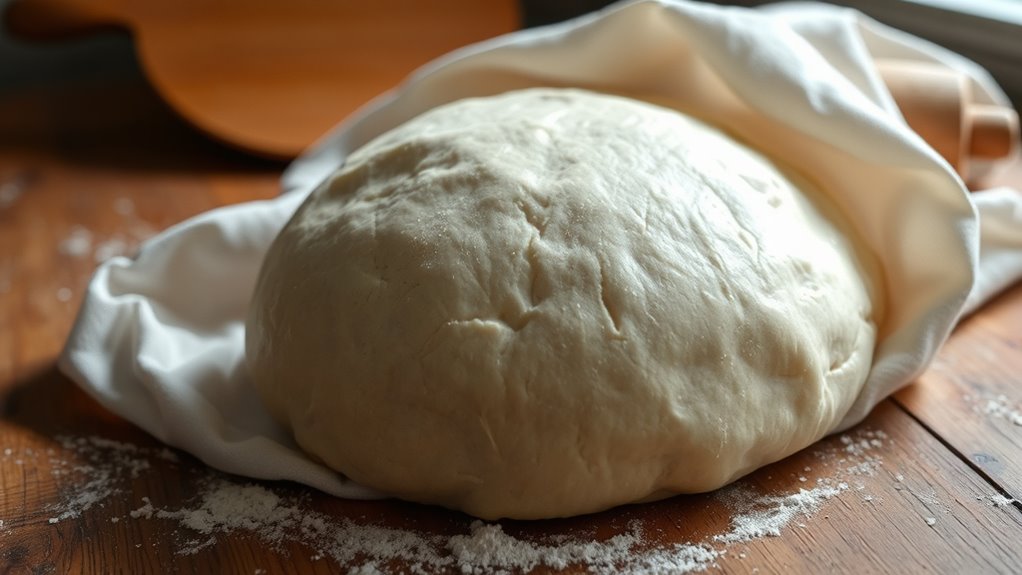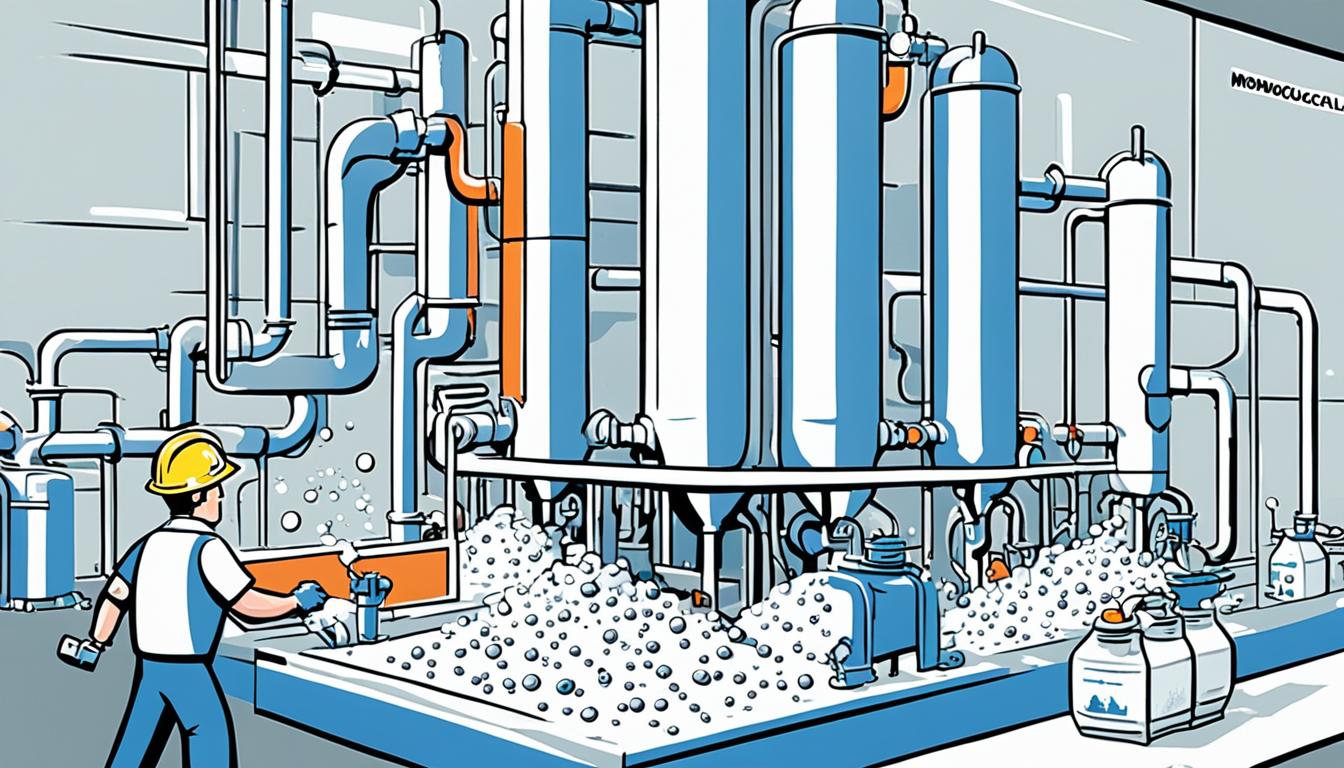Resting dough is the key to achieving that perfect pizzeria crust because it allows gluten to relax, making the dough easier to work with and shaping smoother. It also enhances fermentation, deepening flavor and creating a light, airy texture. Skipping this step results in a dense, tough crust that’s hard to stretch. If you want to release full flavor and perfect texture, keep going — you’ll discover how to maximize the benefits.
Key Takeaways
- Resting allows gluten relaxation, making the dough easier to stretch and shape.
- It enhances fermentation, deepening flavor and developing a more complex crust.
- Rested dough produces a lighter, airier crust with better texture.
- It improves dough extensibility, preventing tearing and uneven stretching.
- Proper resting ensures a crispy outside and tender inside, mimicking pizzeria-quality results.

Resting dough is an essential step in achieving a pizzeria-quality crust, as it allows the gluten to relax and the flavors to develop fully. When you let the dough rest, you’re giving the fermentation process time to work its magic. During fermentation, yeast produces carbon dioxide and alcohol, which not only cause the dough to rise but also enhance its flavor profile. This slow fermentation, especially when done over a longer period, results in a more complex, nuanced taste that’s hard to replicate with rushed methods. The resting period also improves dough elasticity, making it easier to shape without tearing or shrinking back. As the gluten strands relax, you’ll notice the dough becomes more pliable, allowing you to stretch it thin and achieve that perfect, airy crust.
Resting dough relaxes gluten and enhances flavor, resulting in an airy, perfect crust.
Skipping or rushing this step can drastically impact the final quality of your pizza. Without enough resting time, the dough remains tight and difficult to work with, often resulting in a dense or tough crust. When properly rested, the dough develops better extensibility, meaning it stretches smoothly and evenly. This even stretch translates into a lighter, airier texture once baked. Furthermore, the fermentation process during resting helps break down complex starches and proteins, enhancing flavor and creating a more flavorful crust with a subtle tang. This is what sets pizzeria-quality crusts apart—they’re not just about the ingredients but also about the time taken to develop their full flavor potential.
The length of resting varies depending on your recipe, but generally, a longer resting period, such as overnight or even 24 hours, yields superior results. During this time, the dough continues to ferment slowly, which deepens its flavor and improves its structure. You’ll also notice that as the dough rests, it becomes easier to handle, and you can shape it with less effort. This is because the gluten strands, which provide strength and elasticity, have relaxed sufficiently to allow for more extensibility. It’s a delicate balance—resting too little can leave your dough tight and underdeveloped, while resting too long can cause over-fermentation, leading to a sour taste or overly soft texture.
Ultimately, resting dough isn’t just a passive step; it’s the secret to *unleashing* the full potential of your ingredients. It’s what transforms simple flour and water into a crust that’s beautifully airy, flavorful, and resilient enough to hold toppings without collapsing. By respecting this process, you give yourself the best chance to create a pizza crust worthy of a pizzeria—crispy on the outside, tender inside, and bursting with flavor.
Frequently Asked Questions
How Long Should Dough Rest for Optimal Crust?
For ideal crust, you should let your dough rest for at least 1 to 3 hours, depending on your fermentation timing. During this period, keep it in a warm, humid resting environment to develop flavor and improve elasticity. If you have more time, refrigerate it overnight for even better results. Resting allows gluten to relax, making your dough easier to shape and giving you a crisp, flavorful crust.
Can Resting Dough Improve Crust Flavor?
You might wonder if resting dough can truly boost crust flavor. The answer is yes—resting allows fermentation benefits to develop, releasing deeper, richer flavors in your crust. When you give dough time to ferment, the natural enzymes break down starches and proteins, creating complex tastes. So, by resting your dough properly, you enhance flavor development, making your pizza crust more delicious and satisfying with every bite.
Does Resting Dough Affect Crust Texture?
Resting dough considerably affects crust texture by allowing gluten development to stabilize, making it easier to shape and ensuring a tender, chewy bite. During resting, fermentation enhancement occurs, producing gases that create a lighter, airier crust. This process also relaxes the dough’s gluten, preventing toughness. You’ll notice a more consistent and desirable texture, with a perfect balance of chewiness and crispness, once you give your dough adequate resting time.
Is Refrigeration Necessary During Resting?
You might think resting dough is just about patience, but it’s really about revealing its full potential. Refrigeration isn’t always necessary, but cold fermentation is a game changer for dough elasticity, helping develop flavor and structure. When you refrigerate, you slow enzyme activity, enhancing texture and taste. So, yes, chilling during resting is a valuable step, but it’s flexible depending on your schedule and desired crust qualities.
Can Over-Resting Dough Ruin the Crust Quality?
If you over-rest your dough, it can negatively impact fermentation timing and dough elasticity. You might notice the crust becoming overly soft or losing its structure, resulting in a less desirable texture. To avoid ruining your crust, keep an eye on the resting period and avoid extending it too long. Proper timing guarantees a balanced fermentation process, giving you a crust that’s both flavorful and perfectly elastic.
Conclusion
Resting your dough truly transforms your pizza into a perfection. By giving it time, you allow gluten to relax, flavors to deepen, and texture to improve. This simple step sets the stage for a pizza that’s crispy, chewy, and consistently crave-worthy. So, slow down, be patient, and let your dough rest. With this secret, your crust will continually captivate and create countless culinary classics. Rest, relax, and relish the remarkable results.









